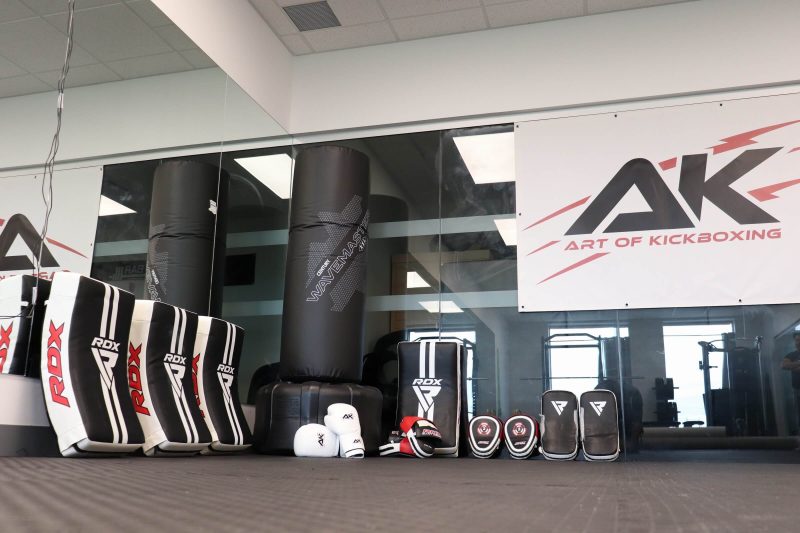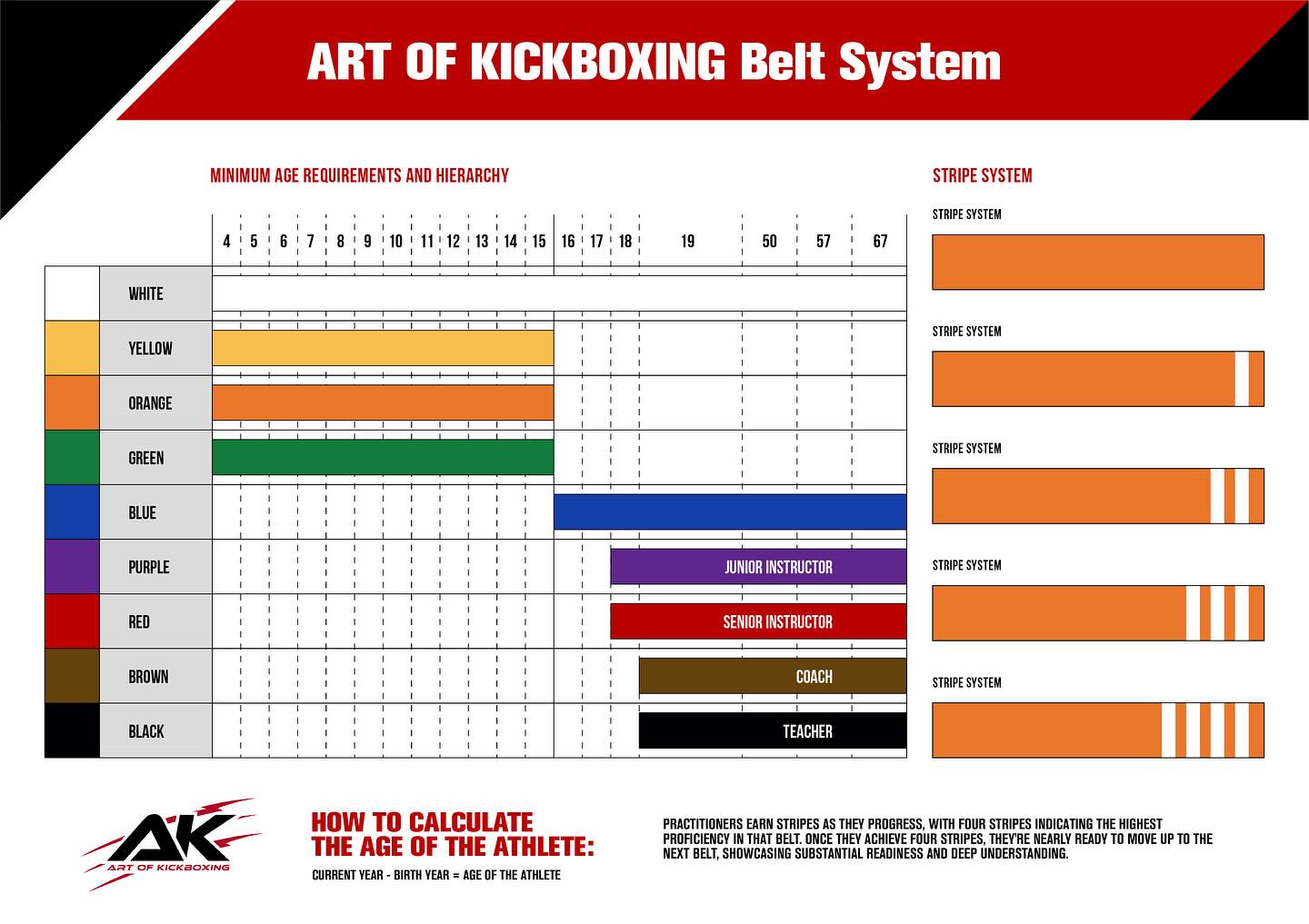Kickboxing Belt System
- Home
- Kickboxing Belt System
Progressive Belt System
Kickboxing Belt System
At Art of Kickboxing, we have a progressive belt system that reflects your mastery and overtime allow you to pursue a career as an instructor or coach. You’ll begin with a white belt, learning the essential fundamentals. As you develop your skills, you’ll progress through color-coded belts: Yellow, Orange, Green, Blue, Purple, Red, and Brown, each indicating a new level of technique and fitness. Achieving a Black Belt is the pinnacle of your training, symbolizing advanced expertise, dedication, and a deep theoretical understanding of kickboxing.
Stripe System Progression
Kickboxing Belt Stripe System and Age Requirements
Our Stripe System within each belt level marks your progress and readiness for the next challenge, with four stripes representing near mastery of your current belt.
- Stripes for Progress
Practitioners earn stripes as they progress, with four stripes indicating the highest proficiency in that belt.
- Progression to Next Belt
Once they achieve four stripes, they are nearly ready to move up to the next belt, showcasing substantial readiness and deep understanding.
- Belt Age Requirements
Each belt has an associated minimum age starting from age 4 for the White belt, up to age 19 and above for the Black belt.
- Instructor Ranks
Between the ages of 19 to 50 and beyond, there are additional ranks or titles such as Junior Instructor, Senior Instructor, Coach, and Teacher.
The minimum age requirements for each belt ensure that our training is tailored to each stage of physical and mental development.
Ranking Up Towards A New Career
Become a Kickboxing Coach
As you ascend through the belt ranks, you’ll not only enhance your personal skills but also take on greater roles within our community, potentially rising to a Senior Instructor or even a Coach. This structured system is designed to promote personal growth and physical prowess, preparing you for advanced techniques, competitive events, and a deep understanding of martial arts.
Our kickboxing belt system promotes a gradual and measurable advancement through the acquisition of skills and maturity, suitable for the physical and cognitive development associated with different age groups. Pursue the art of kickboxing with us and develop an arsenal of techniques and skills to bring with you for the rest of your life.
FAQs
Kickboxing Belt System Questions
In many gyms like ours, a belt grading system is often used to signify the skill level and expertise of practitioners. While the belt colors and black belt grades may differ from school to school, common ranks include White, Yellow, Orange, Green, Blue, Purple, Brown, and various degrees of Black Belt. Each colored belt represents a higher level of mastery over complex combinations and a deeper understanding of kickboxing skills.
Advanced training methods and rigorous training sessions help kickboxers progress through the belt ranks. In kickboxing, the level of expertise is not only displayed by the color of the belt but also by additional stripes or degrees, with a Black Belt indicating a high degree of proficiency. Belt grading involves a range of fitness levels and techniques, from basic strikes to advanced defensive maneuvers.
The journey to a Black Belt involves consistent training, knowledge of techniques, and personal growth. The form of kickboxing varies, incorporating elements from various martial arts systems, and the curriculum is structured to reflect this diversity. Whether it’s American Kickboxing, Muay Thai, or a blend of styles, the belt system serves as a roadmap for the martial artists’ progression and milestones in their kickboxing journey.
Not all organizations or gyms adhere to a belt system. Many kickboxing institutions focus primarily on fitness, technique development, and preparation for competition without incorporating a traditional ranking structure. While the belt system is deeply rooted in martial arts history, providing a clear pathway for progression and achievement, it is not a universal feature kickboxing.
Some practitioners value the belt system for its motivational and structural benefits, yet others thrive in environments where the emphasis is placed on personal improvement, competitive success, and mastery of skills without the formalities of a tiered ranking.
While both kickboxing and Jiu-Jitsu use a belt system to denote skill levels, there are key differences in their approach and symbolism. In Jiu-Jitsu, the belt colors typically progress from white, blue, purple, brown to black, each signifying a deeper understanding and mastery of techniques. The journey from one belt level to another in Jiu-Jitsu often involves rigorous training, a structured curriculum, and demonstration of practical combat skills, with each belt color symbolizing a distinct level of expertise.
In contrast, the belt system in kickboxing varies from school to school, and not all kickboxing styles use a belt system. Those that do, like American Kickboxing or certain forms of competitive kickboxing, might include belts such as yellow, orange, green, blue, brown, and black. These colors might differ in meaning compared to Jiu-Jitsu, often representing a combination of physical fitness, mastery of kickboxing skills (like punches, kicks, and elbow strikes), and understanding of offensive and defensive maneuvers. Advanced belts in kickboxing, like in Jiu-Jitsu, typically denote a high level of expertise and may involve mastery of complex combinations and defensive techniques.
In professional kickboxing, the concept of a belt system is different from traditional martial arts like Karate or Jiu-Jitsu. Professional kickboxing focuses more on competitive fighting and skill demonstration in the ring rather than a progression through a series of colored belts based on skill levels or knowledge.
Instead of a belt ranking system, professional kickboxing often recognizes fighters’ achievements and skill levels through titles and championships. These titles are awarded based on performance in professional fights and tournaments.
For example, organizations like K-1, Glory, or the World Kickboxing Association host championship fights where the winners earn titles like “World Champion” or “National Champion.” These titles are akin to championship belts in boxing and are more about holding a competitive title than denoting a progression of skill levels as in traditional martial arts.

Here’s our schedule & pricing plans. Feel free to contact us for more information.
Start Your Kickboxing JourneY
Progress Through Kickboxing Belts In Order
Begin your kickboxing journey at Art of Kickboxing, where our structured belt system is designed for learners of all levels, from beginners to aspiring instructors.
Starting with a white belt, our program guides you through a series of color-coded belts, each representing a new stage of skill and fitness. Our system is suitable for everyone – kids, teens, and adults, ensuring a tailored and progressive learning experience.
Improve your skills and confidence in a supportive environment. Join us for kickboxing classes and personal training sessions that cater to your individual pace and goals. Whether you’re aiming to improve fitness, learn self-defense, or pursue a career in kickboxing, our program offers a clear path of advancement.


